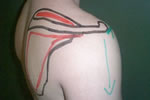A Rotator Cuff Tendonitis is the inflammation of one or more of the rotator cuff tendons. The rotator cuff tendons attach to the front and outside part of the shoulder joint.
The term "rotator cuff" describes a group of 4 muscles:
- Supraspinatus
- Subscapularis
- Infraspinatus
- Teres Minor
The rotator cuff originates from the shoulder blade and attaches to the shoulder itself, forming a cuff surrounding the ball and socket joint of the shoulder. The tendons (the part of the muscle that attaches to the bone) are the "weak link" in this unit and can therefore get irritated or inflamed.
The rotator cuff is a very important component of the shoulder joint:
- Provides movement such as rotation and elevation of the arm
- Helps stabilize the joint
- Adjust the joint position during repetitive and overhead activities
- Reduces the strain on the ligaments & other muscles in the area
|
 |
Pain:
There is pain or tenderness around the shoulder joint, most predominantly in the front. Pain often radiates into the upper arm and, in severe cases, into the forearm to the wrist. Sharp pain is usually felt with overhead activities such as throwing. As the condition gets more severe, pain can be felt with daily activities such as lifting, carrying objects, putting coat or shirt on, reaching into the back seat of the car, washing hair, reaching and lifting from a shelf.
Inflammation:
Inflammation will be present although it may not be visible. It is the result of the irritation of the tendon and the tearing of some tendon fibers.
X-Rays:
Usually the x-rays will be negative. Calcium deposit in advanced chronic stage can be seen occasionally. Arthritic (wear and tear) degenerative changes of the shoulder joint or joint just above (the "AC" joint), which may predispose the rotator cuff to getting injured can sometimes be observed. |
- Occupational overuse
- Overuse in a sport related activity
- Existing weakness of the rotator cuff muscles
- Imbalance of strength between the rotator cuff muscles or the rotator cuff group as a whole in relation
- to the other larger chest and shoulder muscles (pectorals and deltoid) in the area
- Improper technique in activity (sport or
occupational)
- Poor posture, especially forward head posture and forward shoulders,
can cause or perpetuate pain
- and tendon irritation
- Cervical spine nerve pinching
- Improper training schedule, (too much too soon)
- Direct trauma, such as a fall directly onto the shoulder or onto outstretched arm
- A loose or unstable shoulder joint following a previous subluxation, dislocation
- Impingement (pinching) of one of the rotator cuff tendons leading to excess scar tissue formation from recurrent irritation
- Weak shoulder blade area muscles leading to improper stabilization of the shoulder joint
|
A physiotherapist will assess your condition and determine the origin of your pain. Your treatment plan will address both the local symptoms such as pain and inflammation as well as the cause of your pain (see causes above).
If you have developed this problem through a specific activity, your physiotherapist can review your technique and make recommendations to avoid injury.
You will also be given an exercise program that will include proper stretching and strengthening exercises, to maintain the flexibility and strength of the shoulder muscles. With the help of modalities, physiotherapy will reduce your symptoms and promote healing.
To learn more about how you can access and benefit from our services, please contact us today!
|

